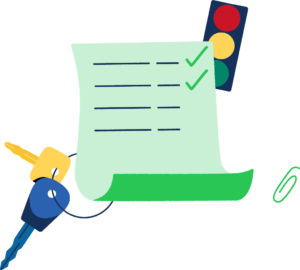12 Economical Driving Tips for Everyone
Driving Tips

Save The Environment – Save Money – Save Lives
Here are a few tips to help you save fuel, save money and possibly even save lives. These tips will help the environment and improve traffic safety.
Drivers Training Academy teaches all these methods during our In-Car behind-the-wheel driving lessons.
Speed
Most vehicles with smaller engines get better gas mileage at lower speeds. According to EPA estimates, driving 55 miles per hour instead of 65 miles per hour will give you a 10-15 percent improvement in fuel economy.
Accelerate and brake smoothly
Accelerating smoothly from a stop and braking softly when approaching a stop, conserves fuel. Fast starts, weaving in and out of traffic and hard braking wears out some the car’s components, such as brakes and tires more quickly. Do not tailgate as tailgating causes the driver to have to brake harder and more suddenly, which not only damages the vehicle mechanically, but also raises the risk of being involved in a collision.
Do Not Idle
Today’s car engines do not require a “warm-up”. Start the car and immediately drive away gently. Leaving your car to idle increases emissions and wastes fuel.
Check Your Tires
Keep tires properly inflated to the recommended tire pressure. This alone can reduce the average amount of fuel use by 3 – 4 percent. Under-inflated tires increase rolling resistance and reduce fuel economy. They also wear out quicker. Check the vehicle’s door-post sticker for minimum cold tire inflation pressure.
Properly Maintain Your Vehicle
Maintain proper engine tune-up to keep vehicles running efficiently. Keep the wheels aligned. Wheels that are fighting each other waste fuel. Replace air filters as recommended. Use a fuel with good detergent additives to keep the vehicle engine clean and performing efficiently. Consult your Owner’s Manual for proper maintenance.
Avoid Extra Weight
Travel lightly and avoid piling a lot of luggage on the roof rack. The added frontal area reduces aerodynamics and will hurt fuel economy, reducing it by as much as 5 percent. Remove excess weight from the vehicle. Unnecessary weight, such as unneeded items in the trunk make the engine work harder and consumes more fuel.
Avoid Unnecessary use of Heater and Air Conditioner
Use heating and air conditioning selectively to reduce the load on the engine. Decreasing your usage of the air conditioner when temperatures are above 80 degrees can help you save 10 – 15 percent of fuel. Use the vent for air as much as possible. Park in the shade to keep the car cooler and reduce the need for air conditioning.
Close the Windows at High Speeds
Don’t drive with the windows open unless you are driving under 50 MPH. Driving with the windows open at highway speeds increases aerodynamic drag on the vehicle and lowers fuel economy.
Use the Right Oil
Choose good quality oil with the viscosity grade recommended in the Owner’s Manual specific for your car.
Consolidate Trips
Plan ahead to consolidate your trips. Plan your errands in a manner that allows you to complete several errands during the same trip.
Plan Your Time for Trips
Whenever possible, drive when traffic is less congested or in less congested routes to avoid sitting in traffic idling.
Need Help? Just Ask.
We want to make sure you receive everything you need to make your drivers education experience as simple and easy as possible. If you run into issues during registration, or if you just need a quick answer about California requirements, we’re here to help! Contact Us 7 days a week.

